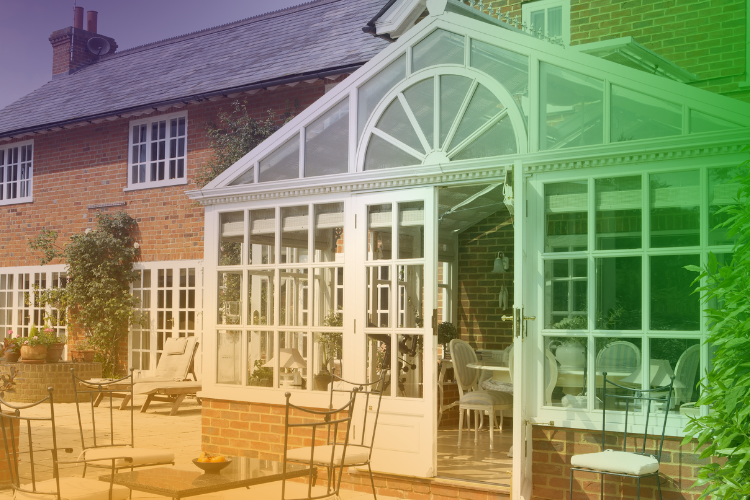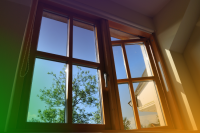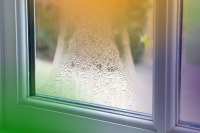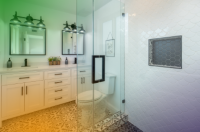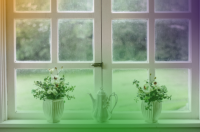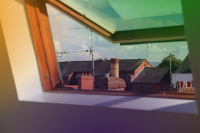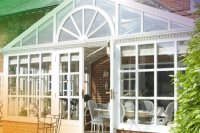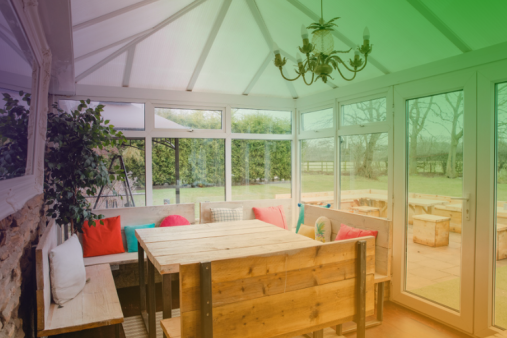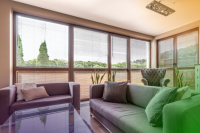Different types of conservatories
There are several types of conservatories available in the UK, each with its own unique features and benefits. Here are some of the most common types:
-
Victorian Conservatory: This is a classic style with a bay front, steeply pitched roof, and ornate detailing. It's a popular choice for period properties.
-
Edwardian Conservatory: Similar to the Victorian style, but with a square or rectangular shape and a flat front. It's a versatile style that suits most types of properties.
-
Lean-To Conservatory: Also known as a sunroom or garden room, this style is simple and contemporary, with a roof that slopes down from the house. It's a great choice for smaller properties or those with limited space.
-
Gable Conservatory: This style features a high, vaulted ceiling that gives a feeling of grandeur and spaciousness. It's perfect for larger properties with high ceilings.
-
P-Shaped Conservatory: This style combines a lean-to conservatory with either a Victorian or Edwardian design, creating a versatile and spacious room that's perfect for entertaining or relaxing.
-
T-Shaped Conservatory: Similar to the P-shaped conservatory, but with a longer central section that creates a more distinct separation between different areas of the room.
-
Lantern Conservatory: This style features a central roof lantern that adds height and drama to the room, as well as letting in plenty of natural light.
Each type of conservatory has its own unique features, and the right one for you will depend on your personal preferences, the style of your home, and the intended use of the space.
Things to consider when buying a conservatory
If you're considering buying a conservatory in the UK, here are some important things to keep in mind:
-
Purpose: Think about how you plan to use the conservatory. Will it be a space for relaxing, entertaining, working, or something else? This will help you determine the size and style of conservatory that's right for you.
-
Design: There are many different styles of conservatories available, so think about the architectural style of your home and choose a design that complements it. You may also want to consider any planning regulations or restrictions that may apply in your area.
-
Materials: Conservatories can be made from a range of materials, including uPVC, wood, and aluminum. Each material has its own benefits and drawbacks, so do your research to find the one that's right for you.
-
Glazing: The type of glazing you choose will affect the performance of your conservatory. Consider factors like energy efficiency, UV protection, and sound insulation when choosing your glazing.
-
Heating and Cooling: Conservatories can get very hot in the summer and cold in the winter, so it's important to consider how you'll heat and cool the space. Options include underfloor heating, radiators, air conditioning, and ceiling fans.
-
Lighting: Think about how you'll light the space, both during the day and at night. Consider options like roof lanterns, wall lights, and spotlights to create a welcoming and functional space.
-
Maintenance: Conservatories require regular maintenance to keep them looking and performing their best. Consider the level of maintenance required for each material and factor this into your decision.
-
Cost: Conservatories can be a significant investment, so it's important to have a clear understanding of the costs involved. Be sure to factor in the cost of materials, installation, heating and cooling, and ongoing maintenance.
By considering these factors, you can make an informed decision and choose a conservatory that meets your needs and enhances your home.
Planning permissions and building regulations when considering a conservatory
In most cases, you won't need planning permission when building a conservatory in the UK. However, there are some exceptions and limitations to this general rule.
If your conservatory meets the following criteria, you won't usually need planning permission:
- It's located at ground level
- It covers less than 50% of the total land area of the property
- It's not higher than the highest part of the roof
- It doesn't extend beyond the rear wall of the original house by more than 3 meters for an attached house, or 4 meters for a detached house
- It doesn't have a veranda, balcony, or raised platform
- It's not located in a conservation area or listed building.
If your conservatory doesn't meet these criteria, you may need to apply for planning permission from your local council. This can be a time-consuming and expensive process, so it's important to ensure that your conservatory meets the guidelines before you start building.
It's also worth noting that even if you don't need planning permission, you may still need to comply with building regulations. These regulations cover issues like structural integrity, energy efficiency, and ventilation, and are designed to ensure that your conservatory is safe and fit for purpose.
Different types of roofs on conservatories
There are several types of roofs available for conservatories in the UK, each with its own unique features and benefits. Here are some of the most common options:
-
Glass roof: A glass roof is a popular choice for conservatories because it allows natural light to flood in, creating a bright and airy space. It also provides great views of the sky and surrounding environment. Glass roofs can be either double or triple glazed for improved insulation.
-
Polycarbonate roof: Polycarbonate is a lightweight and durable material that's often used in conservatory roofs. It comes in a range of colors and is available in different thicknesses for improved insulation.
-
Tiled roof: A tiled roof is a good option if you want your conservatory to blend seamlessly with the rest of your home. It's also a good choice if you want improved insulation and soundproofing. Tiled roofs can be made from materials like slate, clay, or concrete.
-
Lantern roof: A lantern roof is a type of glass roof that's designed to add height and drama to your conservatory. It features a central section that's higher than the rest of the roof, creating a lantern-like effect. This allows even more natural light to flood in.
-
Solid roof: A solid roof is a good option if you want your conservatory to feel more like an extension of your home. It provides excellent insulation and soundproofing, and can be made from materials like timber, aluminum, or steel.
Each type of conservatory roof has its own unique features and benefits, and the right one for you will depend on your personal preferences, the style of your home, and the intended use of the space.
Different types of glass for conservatories
There are several types of glass that are available for conservatories in the UK, each with its own unique features and benefits. Here are some of the most common options:
-
Toughened glass: Toughened glass is a type of safety glass that's heat-treated to make it stronger and more durable than standard glass. It's designed to break into small, harmless pieces in the event of an impact, reducing the risk of injury.
-
Laminated glass: Laminated glass is made up of two or more layers of glass with an interlayer of polyvinyl butyral (PVB) between them. This interlayer provides additional strength and helps to hold the glass together if it's broken, reducing the risk of injury.
-
Double-glazed glass: Double-glazed glass consists of two panes of glass separated by a layer of air or gas. This creates an insulating layer that helps to reduce heat loss and noise transmission.
-
Triple-glazed glass: Triple-glazed glass consists of three panes of glass separated by two layers of air or gas. This provides even greater insulation and noise reduction than double-glazed glass.
-
Low-E glass: Low-E glass (short for low emissivity) is coated with a thin layer of metal oxide that reflects heat back into the room, helping to keep it warm in winter. It also blocks out harmful UV rays and reduces glare.
-
Self-cleaning glass: Self-cleaning glass has a special coating that uses sunlight to break down dirt and grime, making it easier to clean.
-
Solar control glass: Solar control glass is designed to reduce the amount of heat that's transmitted into your conservatory, keeping it cooler in summer.
Each type of glass has its own unique features and benefits, and the right one for your conservatory will depend on your personal preferences, the climate in your area, and the intended use of the space.
What about the foundations?
There are several options available for foundations when building a conservatory in the UK. Here are some of the most common:
-
Strip foundations: Strip foundations are the most popular type of foundation for conservatories. They consist of a concrete strip that runs along the perimeter of the conservatory, supporting the weight of the walls and roof.
-
Raft foundations: Raft foundations are similar to strip foundations, but they cover a larger area. They're usually used for larger conservatories or in areas with poor soil conditions.
-
Piled foundations: Piled foundations are used when the soil is unstable or weak. They consist of a series of steel or concrete piles that are driven into the ground to support the weight of the conservatory.
-
Ground screws: Ground screws are a newer type of foundation that can be used in certain conditions. They consist of a steel screw that's screwed into the ground, providing a stable foundation for the conservatory.
The type of foundation that's best for your conservatory will depend on factors like the size of the conservatory, the soil conditions in your area, and local building codes and regulations. It's important to work with a qualified contractor who can help you choose the best foundation for your specific needs.
You need to also consider ways to keep your conservatory insulated
Insulating a conservatory is essential to keep it comfortable and usable throughout the year. Here are some of the options for insulating a conservatory in the UK:
-
Insulated roofing: One of the best ways to insulate a conservatory is by installing insulated roofing panels. These panels are designed to reduce heat loss in the winter and prevent overheating in the summer, making the space more comfortable all year round.
-
Double-glazed windows and doors: Double-glazed windows and doors are a great way to improve the insulation of your conservatory. They help to reduce heat loss and noise transmission, making the space more energy-efficient and comfortable.
-
Draft-proofing: Draft-proofing is another effective way to improve the insulation of your conservatory. This involves sealing any gaps or cracks around windows, doors, and other openings to prevent heat loss and cold air from entering the space.
-
Underfloor heating: Underfloor heating is a great way to keep your conservatory warm and comfortable in the winter. It works by heating the floor of the space, which then radiates warmth throughout the room.
-
Insulated blinds or curtains: Insulated blinds or curtains can also help to improve the insulation of your conservatory. They can help to reduce heat loss in the winter and prevent overheating in the summer.
-
Insulated wall panels: If your conservatory has solid walls, you may want to consider installing insulated wall panels. These panels can help to reduce heat loss and improve the overall energy efficiency of the space.
The best way to insulate your conservatory will depend on its design, size, and location. It's important to work with a qualified contractor who can help you choose the best insulation options for your specific needs.
Stages of conservatory building
Building a conservatory in the UK involves several stages. Here are some of the key steps involved:
-
Design and planning: The first step in building a conservatory is to design it. This involves working with a qualified contractor or architect to create a plan that meets your needs and fits within your budget. You'll also need to obtain any necessary planning permission or building permits before you can begin construction.
-
Site preparation: Once you have a design in place and all necessary permissions, the site will need to be prepared for construction. This involves clearing the area and preparing the foundation for the conservatory.
-
Framing: The framing stage involves building the structure of the conservatory. This includes installing the walls, roof, and any windows or doors.
-
Glazing: Once the framing is in place, the glazing can be installed. This involves fitting the glass panels into the window and door frames.
-
Electrical and plumbing: If you plan to include electrical or plumbing features in your conservatory, these will need to be installed at this stage.
-
Finishing touches: Once the major construction is complete, the finishing touches can be added. This includes things like painting, flooring, and adding any additional fixtures or fittings.
-
Final inspection: Before you can start using your conservatory, it will need to be inspected by a building inspector to ensure that it meets all necessary safety and building regulations.
The specific stages involved in building a conservatory can vary depending on the design, size, and location of the project. It's important to work with a qualified contractor who can guide you through each stage and ensure that the project is completed to a high standard.
